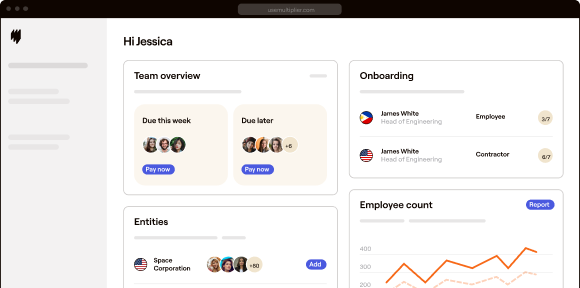If you’re a company that hires independent contractors on a regular basis but are looking to secure their employment with your company, then converting your contractor or freelancer to a full-time employee is your best bet.
This is a win-win situation for both parties as your contractor will receive employee benefits and will no longer have to manage their own taxes. On your end, you will be able to secure specific skills and lock in top talent for your company.
But is conversion from an independent contractor to a full-time employee easy? What are the necessary steps you should take? Is there a specific time that it must be done? We’re answering all of your questions below:
Onboard contractors with our all-in-one employment solution
When should I convert my independent contractor to a full-time employee?
Ideally, you should be able to convert independent contractors to full-time employees within a one year time period. If you are highly satisfied with the work that your freelancer or contractor provides you with, you might already want to consider offering them a full-time position. While not mandatory, the reason it is ideal to convert your independent contractor within a one year time period is to avoid misclassification risks.
Employers must be aware of the definitions and differences between an independent contractor and a full-time employee. They are critical to conversion and will help you avoid misclassification.
Generally speaking, the main differences between the two can be outlined as follows:
- Independent contractors are paid per project, pay their own taxes, use their own equipment, work offsite, and can usually work when and where they want
- Full-time employees are paid a regular wage, have their taxes withheld, use company owned equipment, report to a company office or facility, and have a working schedule that is dictated by their employer
Once you start requiring your independent contractors to go to the office, use company owned equipment, or follow a certain schedule, we recommend converting your independent contractor to a full-time employee immediately. As per the law, if you have any control over the performance of the contractor, he/she can no longer be called as an independent contractor and should be given full time employment status.
How do I convert my independent contractor to a full-time employee?
The process of converting contractors to employees is a multifaceted undertaking that requires careful planning to ensure legal compliance, operational efficiency, and the preservation of positive working relationships. By following a systematic approach, businesses can minimize risks, avoid disruptions, and facilitate a seamless transition for all parties involved. Below is a concise guide detailing the critical steps to achieve a successful conversion.
Establishing legal entity requirements
Converting contractors to employees starts with ensuring your business has the right legal structure in each jurisdiction where the employees will be based. For domestic conversions, verify that your business registration, tax ID, and employment systems are up to date. You may need to update state or federal registrations or expand workers’ compensation coverage.
International conversions are more complex. Businesses must either set up legal entities in foreign countries — navigating local laws, taxes, and labor rules — or work with an Employer of Record (EOR). An EOR serves as the legal employer, handling compliance while you manage daily operations. The choice depends on your company’s goals, budget, and global footprint.
Developing comprehensive employment agreements
Employment contracts formalize the new relationship and differ from contractor agreements by establishing mutual, ongoing obligations. These agreements should include:
- Compensation structure: salary, bonuses, or commissions.
- Benefits eligibility: health insurance, paid leave, retirement plans.
- Work expectations: responsibilities, hours, performance metrics.
- Termination terms: notice periods, severance, grounds for dismissal.
- Restrictive clauses: non-compete or confidentiality terms if needed.
Always consult with legal experts to ensure contracts align with local labor laws and requirements.
Implementing payroll and benefits systems
Employee status brings payroll obligations such as tax withholding, benefits administration, and compliance reporting. Set up direct deposit, configure tax tables, and enroll employees in benefits programs. Time tracking, leave management, and reimbursement systems should also be established.
Investing in integrated HR and payroll platforms helps automate compliance, generate accurate payslips, and provide employees with easy access to benefits and records.
Managing transition communication
Clear communication builds trust and smooths the transition. Talk to contractors early about the reasons for the change, the timeline, and what to expect. Share information about:
- Compensation and benefit changes
- New reporting structures
- Policies under employee status
- Enrollment in payroll and benefits systems
Address concerns promptly through meetings or Q&A sessions to maintain a positive relationship.
Completing legal and administrative requirements
Final steps include:
- Registering new employees with the tax authorities
- Updating workers’ compensation and insurance coverage
- Ensuring labor law compliance (e.g., minimum wage, overtime rules)
- Documenting the conversion process and risk assessments
Regular audits of these systems help catch and fix compliance issues early.
Converting contractors to employees is a strategic move that improves stability and supports business growth. By handling legal, financial, and interpersonal elements with care, you ensure a smooth, compliant transition. This investment pays off in a stronger, more engaged workforce — and long-term organizational success.
What are the benefits of converting my independent contractor to a full-time employee?
There’s a reason why many companies around the world hire independent contractors: they’re flexible, skilled in a certain area, and are sometimes cheaper than paying for a full-time employee. But hiring independent contractors is not the end all, be all solution for everyone. There are plenty of risks involved and you need to consider a few important before hiring them.
Contractor payroll software comes in handy to digitize payroll for independent contractors otherwise known as freelancers. Payroll software for contractors saves a lot of time and manpower for companies that hire them to cater to their business needs at large. Independent contractor payroll software suits small, medium and large-scale business units alike.
PEO companies are companies that handle administrative matters between business owners and independent contractors and freelancers, such as payroll-related taxes and human resources, and provide these services to both parties.
However, you can also minimize these risks by converting your independent contractors to full-time employees. Here are some advantages you can gain by doing so:
- Highly satisfied employees: One huge advantage of full-time employees is their access to benefits. Benefits like healthcare, health insurance, social security, sick, vacation, and parental leave, even pension and housing insurance are all benefits that employees have a right to, which independent contractors do not. Having access to all these benefits will result in highly satisfied employees and possibly even more productive ones.
- Talent retention: By converting your independent contractor to a full-time employee, you’ll be able to secure their skills for the growth and benefit of the company. Instead of having limited access to their skills because of the contractual and per project nature of their job, you’ll be giving your company a competitive advantage by locking in your top talent.
- Employment compliance: When it comes to independent contractors, compliance is a slightly grey area. It is understood that the independent contractor must pay for his or her own taxes; however, many contractors either forget or skip paying taxes which raises questions regarding tax compliance. Employees may also give independent contractors work that is actually qualified as work for a full-time employee, thus skirting around the taxation and benefits requirement. If you do convert an independent contractor to a full-time employee, you will not have to worry about compliance issues as the employer is mandated by law to provide benefits and pay taxes.
What are the challenges of converting my independent contractor to a full-time employee?
- Change in pay: This is inevitable. If you do decide to convert your independent contractor to a full-time employee, you will have to expect change in costs from your end. You will be paying for their benefits as well as their taxes, and this will be coming out of your company’s budget.
- Taxation compliance: Independent contractors are expected to pay their own taxes. However, once you convert them to full-time employees, employers are responsible for withholding taxes on behalf of the employee.
- Local labor law compliance: One challenge when it comes to labor law compliance is local knowledge. (This includes information about national holidays, laws on vacation and sick leaves, overtime pay, severance pay, etc.) Employers will have to be familiar with the local labor laws, which might require heavy research, local agency partnerships, or legal consultation, all of which may also be quite costly.
On top of that, compliance with tax and labor laws may be even more difficult if you have full-time employees from different countries. Each country will have its own set of laws, which may make it difficult for an employer to comply with, organize, and set up.
If you want to avoid the headache and stress that comes with copious research and paperwork, you can use companies like Multiplier that allow you to effortlessly comply with local tax and labor laws.
What happens if I don’t convert my independent contractor right away?
If you don’t convert your independent contractor right away but are requiring them to do work that can be considered full-time, you are at risk of misclassification.
Misclassification happens when a governing body deems the nature of an independent contractor’s job as that of an employee. The consequences of misclassification usually result in heavy fines on the company’s end.
Unfortunately, misclassification in Asia is not uncommon. In 2018, the Philippines’ Department of Labor and Employment cracked down on the Philippine Long Distance Telephone Company, mandating that they regularize over 8,000 contractual workers, and pay a settlement fee of approximately $1.8M USD. In 2019, the Indian multinational company Infosys, was fined $800,000 USD for worker misclassification and tax fraud.
Is there an easier way to convert my independent contractor to a full-time employee?
Yes, there is an easier way to convert your contractor to a full-time employee, and it is called a Professional Employer Organization (PEO). What PEOs do is they essentially act as the entity in the country of your full-time employee, making it possible for you to hire them legally and without the stress and hassle.
If you use a PEO platform like Multiplier, you can easily hire and pay your full-time employees and comply with local labor laws. You won’t need to worry about establishing a local entity or have to figure out how to comply with the local labor laws. With a few clicks you can onboard, manage, and pay your international team in any country with Multiplier. You focus on your business, and Multiplier will take care of the rest.
Want to learn more about how you can use Multiplier to easily convert your independent contractors to full-time employees? You can visit our website or contact us today.







